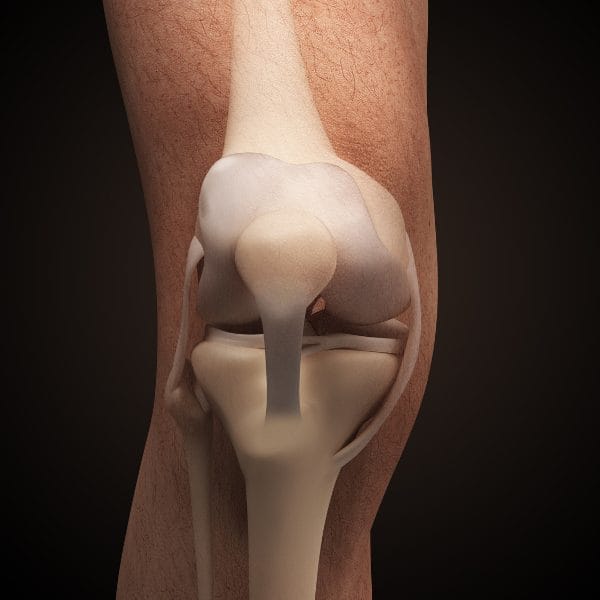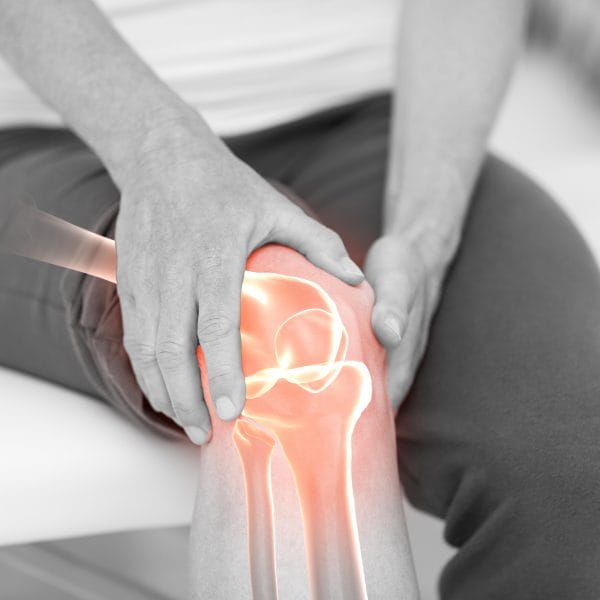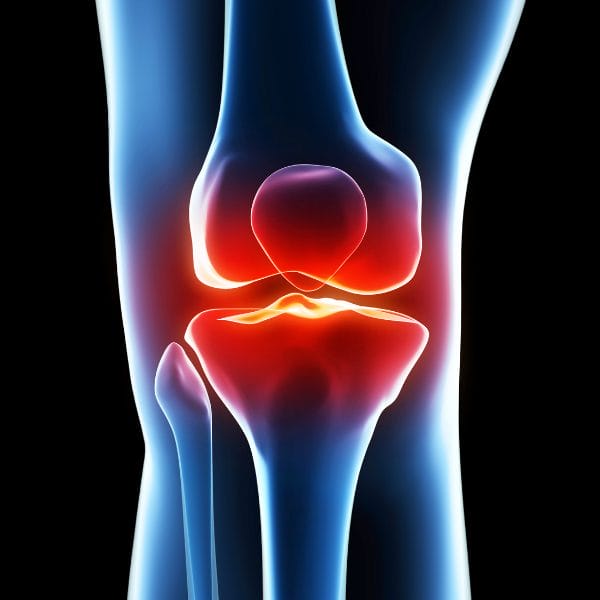Knee Pain: Common Knee Problems, Causes of Pain in the Joint
The knee joint is a complex structure made up of a complex arrangement of bones and ligaments. It’s also an important part of the body – when knee pain occurs, it’s often time to take notice! Unfortunately, several problems can arise in the knee, making it difficult to diagnose pain. This blog post will discuss knee pain symptoms and causes of knee pain to help you find relief!
The knee joint is a complex structure made up of a complex arrangement of bones and ligaments.
PostureGeek.com Tweet
Anatomy of the knee
The knee joint is a hinge joint that connects the femur (thighbone) to the tibia (shinbone) and is responsible for bending and straightening the leg.
The joint consists of four bones:
- the femur,
- the tibia,
- the patella (kneecap), and
- the fibula

The knee is also surrounded by a complex arrangement of ligaments, which hold the bones together and provide stability to the knee. The bone-on-bone knee joint is lubricated by a thin film of synovial fluid, which allows the bones to move smoothly against each other.
The main ligaments are:
- The anterior cruciate ligament (ACL)
- The posterior cruciate ligament (PCL)
- The medial collateral ligament (MCL)
- The lateral collateral ligament (LCL)
- The patellar ligament (tendons connecting knee muscles to the knee cap)

What are common knee problems?

Knee Arthritis
Osteoarthritis is a form of arthritis that affects the knee most often. Osteoarthritis is a degenerative condition in which the cartilage in the joint deteriorates progressively. It commonly affects people in their fifties and up. In addition, excess stress on the joint, such as from frequent trauma or being overweight, can contribute to knee arthritis.
Knee Bursitis
Knee Bursitis is a common knee problem that causes pain around the knee joint from inflammation of the fluid-filled sacs called ‘bursae’. Bursae are positioned throughout our body where muscles and tendons come into contact with bones or other structures, allowing for smooth gliding between these structures. When knee bursitis occurs, the bursae become inflamed and can cause pain and stiffness in the knee joint.
Runner’s Knee
The term “Runner’s Knee” (Patellofemoral pain syndrome) is a catch-all phrase that refers to a variety of knee problems.
Runner’s knee is a condition that affects runners and other athletes who participate in sports that involve running or jumping. Runner’s knee is caused by overuse of the knee joint and results in pain around or behind the knee cap. Runner’s knee is also known as patellofemoral pain syndrome. It can be treated with rest, ice, compression and elevation (RICE), physical therapy, and anti-inflammatory medications.
Meniscus Tear
The menisci are C-shaped pieces of cartilage in the knee joint that act as shock absorbers and help to stabilize the knee. A Meniscus tear can occur from twisting or bending the knee and often cause pain and swelling. If a tear is small, it may not require treatment, but surgery may be necessary to repair it if a larger tear occurs.
ACL Tears
The anterior cruciate ligament (ACL) is one of the knee’s stabilizing ligaments and helps to keep the knee joint stable. ACL tears often happen in sports that require sudden stopping, such as basketball or football. A tear can be complete (the ligaments ruptures completely) or partial – a common type of knee injury. Symptoms of a torn ACL include joint pain, swelling, and instability.
Muscle and/or Ligament Sprain
A sprained or torn knee ligament or muscle is usually caused by a blow to the knee or a quick twist of the knee. Pain, edema, and difficulty walking are typical symptoms.
Patellar Tendinitis
Tendinitis is an inflammation of one or more tendons, which are tough, fibrous tissues that connect muscles to bones. Patellar tendon irritation and inflammation can happen as a result of a patellar tendon injury, which travels from the kneecap (patella) to the shinbone. Patellar tendinitis affects runners, cyclists, and other athletes who frequently engage in jumping sports or activities.
Can muscles lead to knee pain?

Yes, muscles can lead to knee pain. In addition, when the muscles around the knee are weak, they cannot support the knee joint, leading to pain – even more significant injury.
Some common causes of muscle weakness around the knee include:
- overuse or repetitive use of the knee joint
- age
- arthritis
- obesity
- knee injury
Which muscles can lead to knee pain?

The quadriceps muscles, located in the front of the thigh, are the most common muscles that lead to knee pain. These muscles help straighten the knee and can be overused or injured if too much force is placed on them.
The hamstrings, located in the back of the thigh, can also cause knee pain if they are tight and not flexible. When these muscles are tight, they can place more stress on the knee joint and lead to pain.
Strengthening these muscles can help to relieve knee pain. Exercises that target the quadriceps and hamstrings muscles can be found through your doctor or recognized health care provider.
How are knee problems diagnosed?
Knee problems are typically diagnosed through a combination of physical examination and medical imaging.
PostureGeek.com Tweet

Knee problems are typically diagnosed through a combination of physical examination and medical imaging. Physical examination involves a health care provider feeling and moving the knee joint to look for signs of damage or inflammation. Medical imaging such as an X-ray, MRI, or ultrasound may be used to see inside the knee joint and diagnose knee problems.
Important knee imaging tests include:
Physical Exam
Physical Exam can be important in knee injury diagnosis, which is often difficult with knee pain.
A health care provider may ask about your knee problem:
- How it occurred (such as by twisting or bending),
- Where exactly the pain is located (front of the knee vs inner knee),
- What makes the condition better or worse,
- Any other medical conditions a person has, and
- If they are taking any medications.
Other knee problems that may be diagnosed include ligament sprains, patellar tendinitis, and muscle/ligaments tears.
X-ray
An X-ray is a type of medical imaging that uses electromagnetic radiation to take images of internal tissues, bones, and organs. The image created by an x-ray machine can be interpreted as positive or negative – meaning it will show either damaged areas in the knee joint or normal structures.
MRI
Magnetic resonance imaging (MRI) is a procedure that uses magnetism, radio waves, and a computer to produce detailed images of organs and structures within the knee. MRIs help identify knee injuries or conditions involving soft tissues such as ligaments, tendons, cartilage, muscles, blood vessels or nerves.
Ultrasound
Ultrasound is a type of medical imaging that uses high-frequency sound waves to create images of organs and tissues. Ultrasounds are often used to diagnose knee problems in people who cannot have an MRI, such as those with pacemakers or other metal implants.
How can I relieve knee pain?
RICE
RICE is an acronym for Rest, Ice, Compression, and Elevation. These are all methods that can be used to relieve knee pain.
- Rest – When your knee hurts, the best thing you can do is give it time to heal. Take a break from knee-impact activities such as running and high impact aerobics for a few days to allow the pain relief time to kick in.
- Ice – Applying ice packs, gel cold therapy pads or bags of frozen peas wrapped in a cloth can help reduce knee swelling and relieve knee pain by ‘numbing’ the area and decreasing knee inflammation.
- Compression – Wrapping a bandage around the knee can reduce knee swelling and ease knee pain by compressing the area to prevent excess fluid from building up in it. Don’t wrap your knee too tightly as that could restrict blood flow, causing more damage.
- Elevation – Elevating your injured knee above the level of your heart will help decrease knee swelling and pain. Place a pillow or two under your knee when you’re resting to achieve this.
Physical Therapy
Physical therapists are trained in helping people with knee injuries achieve their best possible function through therapeutic exercises that target different muscle groups surrounding the knee joint. The physical therapist may also help recover strength and knee function with other tools such as braces, ultrasound or electrical stimulation.
Posture
The position or stance in which you hold your body while standing, sitting or lying down can put extra pressure on the knee joint. If your posture does not allow for proper knee alignment (i.e., the front of your knee bends too much or your knee sticks out to the side), it can cause pain and discomfort in the knee. Improving your posture may help reduce knee pain.
Some common causes of poor posture that can lead to knee pain include:
- sitting for long periods
- standing in the same position for long periods
- wearing high heels regularly
- walking with a limp
- carrying a heavy load on one side of the body
Exercise
Exercising the muscles surrounding your knee can help strengthen them and improve knee stability. In addition, strengthening these muscles may help protect your knee from injury in the future by increasing knee strength and endurance.
Surgery
Some injuries are beyond what physical therapy can heal. For example, suppose knee pain or instability continue to limit your daily activities. In that case, an orthopedic surgeon can perform knee surgery that may include repairing a torn ligament, removing the damaged cartilage, replacing worn-out knee tissue with healthy cadaver tissue (allograft), or transplanting cells grown in the laboratory into knee tissues to regenerate new knee tissue (autograft).
What can be done to prevent knee pain?
There are many things you can do to help prevent knee pain, such as:
Maintaining a healthy weight: Excess weight puts unnecessary stress on the knee joint, leading to pain and other knee problems.
Exercising regularly: Regular exercise strengthens the muscles around the knee joint, which can help protect it from injury.
Wearing knee pads when playing sports: Knee pads help protect the knee from getting injured if you fall or slide on the ground.
Stretching regularly: Stretching regularly your hamstring, quadriceps and calf muscles helps keep them flexible and can help prevent knee pain.
What causes pain in knees without injury?

One of the most common causes of knee pain is knee arthritis. Knee arthritis is a condition that affects the knee joint and can cause pain, stiffness, and inflammation in the joint. Knee arthritis is often the result of damage to the knee joint, such as from injury or overuse. Other causes of knee pain without injury can include knee instability, knee swelling, and knee infection.
The two types of arthritis that can cause knee pain, such as:
Osteoarthritis: Osteoarthritis is the most common type of arthritis and is a degenerative condition that affects the knee joint. It occurs when the cartilage that cushions the knee joint wears down over time.
Rheumatoid arthritis: Rheumatoid arthritis is an autoimmune disease that causes inflammation in the knee joint.
How do I know if my knee pain is serious?
There are a few signs that knee pain may be serious and require medical attention.
These signs include:
- knee swelling,
- knee instability,
- severe pain in the knee that doesn’t go away with self-care measures,
- inability to bear weight on the knee,
- redness or warmth around the knee joint and sudden onset of local pain after a knee injury.
If you have any concerns about knee pain, you should always check with your doctor for an examination. If knee symptoms are not getting better or if there is any redness, warmth, swelling, or pus around the knee joint, it may be a sign of infection, and you should seek medical attention immediately.
If knee symptoms occur following an injury to the knee (such as after a knee sprain or fracture), you should seek medical attention if symptoms do not improve within a few days.
If you have knee pain along with any of these other symptoms, it may also be essential to consult your doctor:
- knee swelling that occurs suddenly and is severe,
- knee stiffness in the morning that lasts for more than an hour,
- knee pain that wakes you up at night, or
- knee pain that limits your activities.
Is walking good for sore knees?
Low impact walking is one of the best activities to relieve knee pain. It helps strengthen muscles in and around the knee joint while also improving cardiovascular health.
PostureGeek.com Tweet
Yes! Low impact walking is one of the best activities to relieve knee pain. It helps strengthen muscles in and around the knee joint while also improving cardiovascular health.
If you are overweight, have arthritis in the knees or hips, poor balance or coordination or any other health conditions affecting the lower extremities, including neuropathy (numbness and tingling), peripheral arterial disease (PAD), or knee osteoarthritis, you should talk to your doctor before beginning any exercise routine.
Does knee pain go away?
The answer to this question depends on the cause of the knee pain. Knee pain will go away with time and appropriate treatment in many cases. However, the pain may be chronic in some cases and may not go away without some intervention and assistance. For example, suppose knee pain is due to knee arthritis or knee injury. In that case, it may be possible for the condition causing the knee pain to heal and for symptoms of knee pain such as swelling and stiffness in the joint to resolve with proper treatment.
Finally
Knee pain is one of the most common knee issues among adults. The knee joint has many problems that can cause knee pain and should be taken seriously, especially if accompanied by other symptoms such as swelling or redness around the knee joint.
In addition to causing knee pain, these conditions may also lead to instability in your knees which can make it difficult for you to carry weight on them without feeling a lot of discomfort.
If you experience any ongoing knee pain talk to your doctor or health care provider about how you might help relieve some of this discomfort and improve stability in your joints so you can live life more fully.
PLEASE NOTE
PostureGeek.com does not provide medical advice. This information is for educational purposes only and is not intended to be a substitute for professional medical attention. The information provided should not replace the advice and expertise of an accredited health care provider. Any inquiry into your care and any potential impact on your health and wellbeing should be directed to your health care provider. All information is for educational purposes only and is not intended to be a substitute for professional medical care or treatment.
